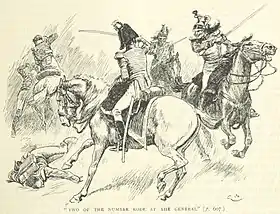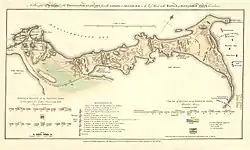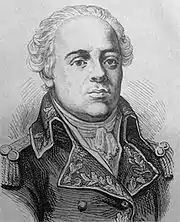Battle of Alexandria (1801)
The Battle of Alexandria, or Battle of Canope, was fought on 21 March 1801 between the army of Napoleon's French First Republic under General Jacques-François Menou and the British expeditionary corps under Sir Ralph Abercromby. The battle took place near the ruins of Nicopolis, on the narrow spit of land between the sea and Lake Abukir, along which the British troops had advanced towards Alexandria after the actions of Abukir on 8 March and Mandora on 13 March. The fighting was part of the French campaign in Egypt and Syria against the Ottoman Empire, which began in 1798.[8]
| Battle of Alexandria | |||||||
|---|---|---|---|---|---|---|---|
| Part of the French Campaign in Egypt and Syria during the War of the Second Coalition | |||||||
 The Battle of Alexandria, 21 March 1801, Philip James de Loutherbourg | |||||||
| |||||||
| Belligerents | |||||||
| [[File:|23x15px|border |alt=|link=]] United Kingdom |
| ||||||
| Commanders and leaders | |||||||
|
[[File:|23x15px|border |alt=|link=]] Ralph Abercromby (DOW) [[File:|23x15px|border |alt=United Kingdom of Great Britain and Ireland|link=United Kingdom of Great Britain and Ireland]] John Hely-Hutchinson [[File:|23x15px|border |alt=United Kingdom of Great Britain and Ireland|link=United Kingdom of Great Britain and Ireland]] John Moore (WIA) [[File:|23x15px|border |alt=United Kingdom of Great Britain and Ireland|link=United Kingdom of Great Britain and Ireland]] Eyre Coote [[File:|23x15px|border |alt=United Kingdom of Great Britain and Ireland|link=United Kingdom of Great Britain and Ireland]] John Doyle [[File:|23x15px|border |alt=United Kingdom of Great Britain and Ireland|link=United Kingdom of Great Britain and Ireland]] John Stuart [[File:|23x15px|border |alt=United Kingdom of Great Britain and Ireland|link=United Kingdom of Great Britain and Ireland]] Sidney Smith (WIA) |
| ||||||
| Strength | |||||||
|
12,000[1][2] 14,200[3] |
10,000[2] 14,000[4] 16,000[5] | ||||||
| Casualties and losses | |||||||
| 1,500[6][2] |
1,700[3] 3,500[2] 4,000[6] 5,000[7] | ||||||
 Location within Mediterranean | |||||||
Prelude
Following Lanusse's reverse at Mandora, Menou finally arrived from Cairo to take direct command of French forces, and determined to attack on 21 March. François Lanusse would lead on the left with the brigades of Valentin and Silly, supported by the infantry Divisions of Antoine-Guillaume Rampon in the centre and Jean Reynier on the right.
The British position on the night of 20 March extended across the isthmus, the right wing resting upon the ruins of Nicopolis and the sea, the left on the lake of Abukir and the Alexandria canal. The line faced generally south-west towards the city, the reserve division under Major-General Sir John Moore on the right, the Foot Guards brigade under George Ludlow in the centre, and three other brigades on the left under Eyre Coote, John Cradock and Earl Cavan. In the second line were two infantry brigades and the cavalry (dismounted).
Battle
Abercromby anticipated a night attack, so on 21 March, the British slept in position under arms. At 3:30 a.m. the French attacked and drove in the British outposts. Moving forward rapidly with great gallantry from the left, Lanusse launched the attack with Valentin's brigade in column along the seashore, and to their right Silly's brigade against the British entrenchments around the Roman ruins. The brunt of the attack fell upon Moore's command, and in particular upon the 28th (North Gloucestershire) Regiment of Foot. The British repulsed this first assault, during which both Silly and Lanusse were hit. “General Lanusse saw that General Valentin had left the seashore, and was within the re-entering angle of the redoubt and the Roman camp, where the cross fire of the enemy held him back. General Lanusse marched to this spot, encouraged the men, and made them advance. The worthy general was hit in the thigh by a ball from a gun-boat; four grenadiers tried to carry him off, but a second ball killed two of these brave fellows”.[9]
Soon Rampon's command in the centre was engaged, and despite disorientation in the dark, penetrated between the front and rear wing of the 42nd Regiment of Foot. A confused fight ensued in the ruins, in which the French troops were all either killed or captured with the 42nd taking their colour.[10] Other British regiments engaged were the 23rd Regiment of Foot, 40th (the 2nd Somersetshire) Regiment of Foot and 58th (Rutlandshire) Regiment of Foot, together with Stuart's Minorca Regiment.



During this time, Menou had devolved command to his subordinates, and was seen gesticulating wildly at the rear "more as if he were a spectator than the commander in chief".[11] However he now ordered his reserve cavalry forward in an unsupported charge. The commander, Cézar Antoine Roize remonstrated in vain, the Republican cavalry nevertheless were able to penetrate as far as the British camp and Abercromby's headquarters, inflicting severe losses on the 42nd Foot[10] before a combination of dug fortifications and musketry ended this effort.
"Turning to his brave men, General Roize said, ‘Friends, they are sending us to glory and death! March!’ The charge was terrible… Brave General Roize, seeing his first line driven back, advanced with the second, made a desperate charge, and penetrated to the camp of the second English line, sabring and overthrowing all in his road. The terrified English threw themselves on their faces on the ground; others fled to their tents; but this obstacle stopped the terrible rush of our cavalry and caused our ruin. The English had dug wolf-pits in their camp, and strewn caltrops about, plentifully. The horses fell into these pits, or were entangled amongst the cords and tent pegs. The brave and unfortunate General Roize, finding there was no chance of escaping from such a position, dismounted, fought like a lion, and was killed, as were also his men”[12]
The front and rear ranks of the 28th Foot were simultaneously engaged to both their front and rear, the soldiers receiving the order "Front rank stay as you are, rear rank about turn". In commemoration the regiment later adopted a second cap badge, the 'Back Number,' worn at the back of their head-dress.[13] During the attack of Roize's second line Sir Ralph Abercromby was briefly captured by French dragoons, but quickly rescued by a highlander of the 42nd. About this time he received a bullet wound to the thigh which would eventually prove fatal, though he remained on the field and in command to the end. Rampon's renewed infantry attack on the centre was repulsed by the Guards brigade, supported by Coote's brigade, and the left wing maintained its position with ease, but the French cavalry for the second time came to close quarters with the reserve.
About half-past eight the combat began to wane, and the last shots were fired at ten. Most of the attacks had been pressed home on the British right, the History of the Queen's Royal West Surrey Regiment praises the regiments of the reserve, saying that "the determined attack would have been successful against almost any other troops." Technically, the details of the action show that, while not markedly better in a melee than the war-seasoned French, the British infantry had in its volleys a power that no other troops then existing possessed, and it was these volleys that decided the day even more than the individual stubbornness of the men.
The 42nd, twice charged by cavalry, had but 13 men wounded by the sabre. Part of the French losses were caused by the gunboats which lay close inshore and cannonaded the left flank of the French columns, and by a heavy naval gun which was placed in battery near the position of 28 March.
Aftermath
The armies engaged on this day both numbered approximately 14,000 men.[4] Losses for the British were, 10 officers and 233 men killed, 60 officers and 1,193 men wounded and 3 officers and 29 men missing. Amongst the senior officers the dead included Abercromby (who succumbed to his wound on 28 March), Lt Col David Ogilvy of the 44th Foot and Lt Col Dutens of the Minorca regt.[14] Moore, Oakes and the Adjudant General John Hope were wounded. The French suffered 1,000 dead, 600 wounded and 200 prisoners, though Fortescue considers up to 4,000 overall. Amongst the French casualties were three generals killed (Lanusse, Roize and brigade commander Baudot in Reynier's Division) and several other senior officers wounded. Additionally the flag of the 21st Light demi-brigade and one Austrian cannon were lost.[11]
John Hely-Hutchinson replaced Abercromby in command of British forces, which then advanced upon Alexandria to laid siege to it. The French garrison surrendered on 2 September 1801.
Reynier heavily criticised Menou in his mémoires[15] on his return to France - Bonaparte ordered the mémoires suppressed in 1802 for this reason (and possibly others). In their defence, Menou, Rampon and Lagrange however all blamed Reynier, Damas and Lanusse for the defeat.[16]
See also
Notes
- Divall 2018, p. 98.
- Bodart 1908, p. 360.
- Hawks 1865, p. 5.
- Tucker 2010, p. 1028.
- Divall 2018, pp. 91–92.
- Clodfelter 2008, p. 112.
- Divall 2018, p. 97.
- Mackesy 1995.
- François 1906, pp. 130–131.
- Atkinson 1911, p. 571.
- Phipps 1926, p. 434.
- François 1906, pp. 133–134.
- Gloucestershire Museum 2023.
- Bisset 1803, p. 428.
- Reynier 1802.
- Mackesy 1995, p. 228.
References
- Atkinson, Charles Francis (1911). . In Chisholm, Hugh (ed.). Encyclopædia Britannica. Vol. 1 (11th ed.). Cambridge University Press. p. 571.
- Bisset, Robert (1803). The History of the Reign of George III to the termination of the Late War. Vol. VI. London: Oxford University Press.
- Clodfelter, M. (2008). Warfare and Armed Conflicts: A Statistical Encyclopedia of Casualty and Other Figures, 1492-2007 (3th ed.). Jefferson, North Carolina: McFarland. ISBN 978-0786433193.
- Divall, Carole (2018). The British Army in Egypt 1801. Warwick: Helion. ISBN 978-1-911628-14-9.
- François, Capt. Charles (1906). From Valmy to Waterloo. Extracts from the diary of Capt.Charles François, a soldier of the Revolution and the Empire. Vol. VI (facsimile ed.). London: Everett & co.
- Gloucestershire Museum (2023). "Battle of Alexandria". Soldiers of Gloucestershire Museum. Retrieved 15 May 2023.
- Hawks, Francis Lister (1865). Appletons' Cyclopædia of Biography: Embracing a Series of Original Memoirs of the Most Distinguished Persons of all Times. D. Appleton & Company. p. 5.
- Mackesy, Piers (1995). British Victory in Egypt, 1801: The End of Napoleon's Conquest. Psychology Press.
- Phipps, Ramsay Weston (1926). The Armies of the First French Republic and the Rise of the Marshals of Napoleon I. Vol. V. London: Oxford University Press.
- Reynier (1802). Mémoires du Général Reynier sur les operations de l'Armée d'Orient en de l'Égypte après la bataille d'Heliopolis (1st edit (suppressed) ed.). Paris.
- Tucker, Spencer (2010). A Global Chronology of Conflict: From the Ancient World to the Modern Middle East. ABC-CLIO. p. 1028.
- Bodart, Gaston (1908). Militär-historisches Kriegs-Lexikon (1618-1905). Retrieved 15 June 2023.
Further reading
- Barthorp, Michael. Napoleon's Egyptian Campaigns 1798-1801 (Osprey Publishing, 1978).
- Fortescue, Sir John. "The History of the British Army" Volume IV Part II.
External links
 Media related to Battle of Alexandria at Wikimedia Commons
Media related to Battle of Alexandria at Wikimedia Commons